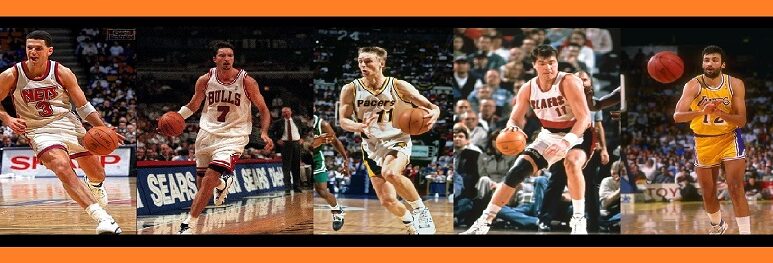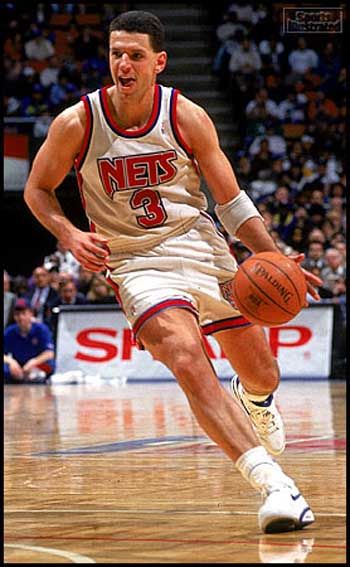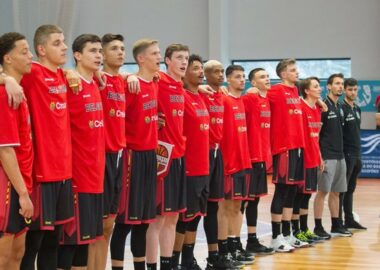
The 10 Greatest European Players in NBA History
(Part 1 of 2) Every year, teams across the NBA draft a fresh batch of international ballers; many of whom are European Players. The 2020-2021 season includes 107 international players from 41 countries, with all 30 teams having at least one foreign player.
Europe, in particular, has been a wellspring of exceptional basketball talent since the 1980s. The rise of talented players from Europe changed the way NBA basketball is played. Now, much emphasis is placed on fundamentals, discipline, and all-around expertise regardless of size, height or position.
The “big man’s” role has evolved from a one-dimensional post-up scorer and rebounder to a more finessed, multifaceted performer. All five players are legitimate three-point shooter options and the deceptively simple ‘Euro step’ has emerged as a potent offensive move.
Reshaping & Energizing the League
Over the years, a number of European players have achieved legendary status for their achievements and contribution to the sport. These athletes have reshaped and energized the league and inspired generations of future basketball superstars.
As a tribute to European basketball’s enduring legacy, we’ve compiled a roster of the greatest European players in NBA history. This list only includes retired or inactive players so as to assess accomplishments in a more definitive and career-wide context.
Here are our 10 to 6 top choices.
10. DRAZEN PETROVIC, CROATIA

Before coming to the NBA, 6-foot-5 (1.96 m), 195-pound (88 kg) Drazen Petrovic was a certified European basketball legend. He had led teams to medals and championships at the Olympic Games and in amateur and professional leagues throughout Europe. The prolific shooting guard had garnered successive European Best Player awards and scoring titles from 1985 to 1989.
He had a rough start in the NBA, playing in a crowded guard roster for the Portland Trailblazers’ 1989-1990 season. Portland’s coaching staff saw Petrovic solely as a long-range shooter, stationing him behind the arc to catch and shoot three-pointers. He played an average of 12.6 minutes per game, which was reduced further to 7.4 minutes in his sophomore year. Frustrated and angry at how the Trailblazers’ management was treating him, Petrovic demanded to be traded.
Showcasing His Talents
With his 1990-1991 mid-season transfer to the New Jersey Nets, Petrovic finally had a chance to showcase his talents. Coming off the bench, he contributed 12.6 points on 50% field goal shooting in 20.5 minutes per game. Petrovic became a starter for the Nets’ 1991-1992 season, racking in 20.6 points on 50.8% shooting from the field. His excellent shooting, fearless slashing offense, and court orchestration led the Nets to its first playoff appearance since 1986. Petrovic achieved a career-high 22.3 points per game average the following season on 51.8% field goal and 44.9% three-point shooting.
Sadly, the 28-year-old Petrovic died in a car accident in Germany on June 7, 1993. He passed away in his prime, yet to realize his fullest potential in the NBA. Petrovic holds the NBA’s fifth all-time highest three-point shooting average of 43.7%. He was inducted into the Naismith Memorial Basketball Hall of Fame in 2002 and the FIBA Hall of Fame in 2007. In the 2013 FIBA EuroBasket, players voted Petrovic as the best European basketball player in history.
9. TONY KUKOC, CROATIA

It can be intimidating to join a team that includes Michael Jordan, Scottie Pippen, and Dennis Rodman. However, Tony Kukoc fit right in with the fabled Chicago Bulls team that achieved its second three-peat in the 90s.
Kukoc is used to excellence. He started playing pro basketball at 17 years old in his native Croatia, winning titles and MVPs along the way. As a member of the Yugoslavian and later Croatian national teams, Kukoc won silver medals in the Summer Olympic Games of 1988 and 1992.
The “Croatian Sensation” started his NBA rookie season in 1993 as a reliever for forwards Scottie Pippen and Horace Grant. By the end of the 1994-1995 season, Kukoc was a starter and second only to Pippen in scoring, rebounds, and assists.
The Ultimate Role-Player & Reliever
Upon Jordan’s return from retirement and the acquisition of Dennis Rodman, Kukoc became the ultimate role-player and reliever. He skillfully filled the positions of the Bulls’ big three and future hall of famers Jordan, Pippen, and Rodman. The NBA named Kukoc Sixth Man of the Year in 1996.
Kukoc was a key component of the Bulls’ three consecutive NBA Championships in 1996, 1997, and 1998. He had a deft touch from long range and the flexibility to play all five positions with poise and confidence. He was also a keen passer, a tenacious defender, and a go-to player during pressure-filled, clutch situations.
8. DETLEF SCHREMPF, GERMANY

The Dallas Mavericks drafted Detlef Schrempf in 1985 to become the first-ever German-born player to play in the NBA. Schrempf’s entry into the league paved the way for fellow countrymen Dirk Nowitzki, Dennis Schröder, and Maxi Kleber, among others.
He played four seasons in Dallas, averaging 8.3 points in 19.4 minutes per game as he adjusted to the NBA. The 6-foot-10 (2.08 m) forward finished with the league’s second-highest three-point percentage (47.8%) during the Mavericks’ 1986-1987 season.
The Consummate Role-Player
It was Schrempf’s stint with the Indiana Pacers, and later the Seattle SuperSonics, that fully displayed his versatility and reliability. He was a consummate role-player; his hustle and hard work were perfect complements to the teams he played for. Schrempf was rewarded with back-to-back Sixth Man of the Year awards (1991, 1992) and three All-Star game appearances (1993, 1995, 1997). He helped the SuperSonics reach the 1996 NBA Finals, losing to the Chicago Bulls in six games.
Schrempf is one of the most efficient European players of all time. In a 16-year career playing for four different teams, he averaged only 29.6 minutes of playing time per game. Yet, he managed to post a career average of 13.9 points, 6.2 rebounds, 3.4 assists per game. He retired with 15,761 points on 49.1% field goal shooting, 38.4% three-point shooting, and 80.3% from the line.
7. ARVYDAS SABONIS, LITHUANIA

Arvydas Sabonis was born in Lithuania, then a part of the Soviet Union during the height of the Cold War. Many considered the 7-foot-3 (2.21 m) center as the best player outside the United States in the 1980s. Unfortunately, the Soviet Union’s iron-fisted control over its national team players kept him from playing in the United States.
The collapse of the Soviet Union in 1991 finally opened the doors for his entry into the NBA. In 1995, the 30-year-old Sabonis started his “rookie” season in the NBA for the Portland Trailblazers. Injuries sustained from years of playing for the USSR, Lithuania and the European pro circuit physically diminished him. Still, he averaged 14.5 points and 8.1 rebounds in 23.8 minutes during the regular season and 23.6 points with 10.2 rebounds in the postseason. Sabonis finished his first year as runner-up for the Rookie of the Year and Sixth Man of the Year voting.
Plowing Through Injuries
Through recurring injuries that further reduced his athleticism, Sabonis played six more seasons in Portland. Playing with tenacity and determination, he frequently offered glimpses of his former excellence and dazzle. The big man displayed his passing skills, shot-blocking and rebounding expertise, perimeter and long-range shooting accuracy, and court leadership.
The Portland Trailblazers reached the playoffs in all of Sabonis’ seven seasons. As starting center, he helped lead the franchise to two consecutive Western Conference Finals appearances in 1999 and 2000. In 470 games, Sabonis averaged 12 points, 7.3 rebounds and 2.1 assists with a 50% field goal shooting clip.
Sabonis retired at forty years old after 23 years of relentless and grueling top-level basketball. FIBA inducted him into the Hall of Fame in 2010 and the Naismith Memorial Basketball Hall of Fame welcomed him in 2011. To this day, basketball experts speculate how dominant he could have been had he entered the NBA in his prime.
6. VLADE DIVAC, SERBIA

The Los Angeles Lakers drafted Vlade Divac in 1989 just as Kareem Abdul-Jabbar was wrapping up his career. He had made his mark as a center for the Yugoslavian national team and European clubs Sloga and KK Partizan.
For seven seasons in Los Angeles, the 7-foot-1 (2.16 m) Divac was a consistent, tireless workhorse with a well-rounded game. He was named to the 1989–90 NBA All-Rookie First Team after averaging 8.5 points and 6.2 rebounds per game. After Abdul-Jabbar’s retirement, he became the starting center and helped the franchise reach the 1991 NBA Finals.
The Hornets Trade & the Sacramento Golden Era
In 1996, Divac was traded to the Charlotte Hornets in exchange for the draft rights to Kobe Bryant. He averaged 11.7 points and 8.6 rebounds in two seasons for the Hornets before signing with the Sacramento Kings. Divac’s more polished, assured game and de facto leadership ushered a golden era for the young Sacramento squad. The Kings’ energetic style produced consecutive winning seasons and playoff appearances, including a trip to the 2002 Western Conference Finals.
Divac retired in 2005 after sixteen years in the NBA. He has a career average of 11.8 points, 8.2 rebounds, and 3.1 assists with a 49.5% field goal shooting efficiency. He is one of only seven players to amass at least 13,000 points, 9,000 rebounds, 3,000 assists, and 1,500 blocks. In 2010, Divac was inducted into the FIBA Hall of Fame and in 2019, the Naismith Memorial Basketball Hall of Fame.
(European Players)



